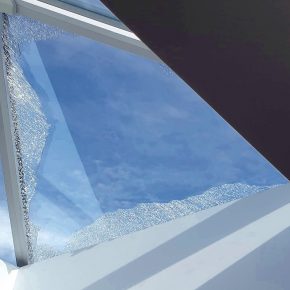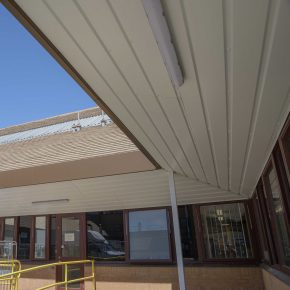
The ins and outs of rooflight safety with NARM
 Mark Wilcox, Safety Representative for NARM, the National Association of Rooflight Manufacturers, explains the role that NARM is playing in improving safety standards for workers outside on the roof – as well as for those inside the building.
Mark Wilcox, Safety Representative for NARM, the National Association of Rooflight Manufacturers, explains the role that NARM is playing in improving safety standards for workers outside on the roof – as well as for those inside the building.
“NARM was formed in the late 1990s, to provide a unified voice for the UK’s rooflight industry and to identify and promote best practice in rooflight specification and installation. Although a relatively small trade association, NARM has always ‘punched above its weight’ and today occupies a respected position, informing government and standards bodies in respect of all aspects of rooflighting, as well as supporting member companies and the wider construction industry.
Over the years, a number of topics have remained central to NARM’s work, key among these being safety. In my role as NARM’s safety representative and sitting on the UK’s Advisory Committee for Roofsafety* (ACR), I’m proud to be playing a part in this important work.
Outside on the roof – safety for workers
NARM works in close collaboration with ACR, which is the organisation behind the widely referenced Red Book: ACR(M)001 ‘Test for Non-Fragility of Large Element Roofing Assemblies’. This defines a test for non-fragility which can be applied to any roof assembly, intended to indicate whether the roof can support the instantaneous loads imposed on it by a person falling or stumbling on it. It is not a product test but products such as rooflights can be tested as part of a roof assembly.
NARM built on that excellent work by collating extensive rooflight test data from members, to create a Technical Document entitled NTD03 Application of ACR[M]001 ‘Test For Non-Fragility of Large Element Roofing Assemblies to GRP Profiled Rooflight Sheeting’. This provides comprehensive coverage of non-fragility requirements for industrial rooflights.
In the case of glass rooflights, there are unique safety issues which require a different testing standard. Glass may pass the ACR soft body impact test, but it is particularly susceptible to hard body impacts that do not form part of the ACR test.
This has been recognised by the glass industry for some time and as a result the Centre for Window and Cladding Technology (CWCT) devised specific non-fragility tests for large area glazing.
Red Book
These are referenced in the latest issue of ACR’s Red Book and NARM has recently published a document entitled Understanding CWCT Classifications of Rooflight Types, providing practical guidance for installers and specifiers.
We have also published guidance designed to clarify definitions of ‘walk-on’ rooflights, to avoid potentially dangerous specification errors. Our Technical Document NTD11 Understanding the differences between ‘non-fragile’ rooflights and ‘walk-on’ rooflights for deliberate foot traffic provides details and definitions.
I’m happy to report that due to ongoing safety initiatives, to my knowledge there have been no recorded fatalities caused by falls through rooflights of any kind manufactured since 2005.
However, the risk remains in locations where older rooflights are still in use and there is never any room for complacency when workers are required to access potentially fragile roof constructions.
When accessing roofs, for avoidance of doubt, ACR’s Orange Book, a good practice guide for work on profiled sheeted roofs, states: ‘Before commencing any work on an existing roof, it is absolutely essential that you find out whether your roof is fragile or non-fragile. This is a key decision, which should only be made by persons competent to do so. If there are any doubts, assume that the roof is fragile.’
Inside – protecting building occupants
In recent years, NARM has been made aware of a number of complaints from individuals or organisations who have installed what they believed to be high quality rooflights, only to be disappointed. More importantly, a number of these complaints have highlighted major safety concerns for building occupants.
Some of these complaints relate to products which are clearly unfit for purpose, including standard DGUs mounted horizontally to a timber frame, to form a ‘rooflight’ of sorts. Others, however are less obvious but potentially equally dangerous. The use of inappropriate glazing materials in a seemingly ‘correct’ rooflight is a case in point.
Current British Standards define that inner panes on rooflights must be laminated in applications more than five metres above floor level (increased to 13 metres in limited circumstances) or are located over water (eg swimming pools).
However, the relevant standard permits use of toughened glass inner panes in other applications, if a risk assessment is carried out and confirmation provided that this does not present additional risk to those below the rooflight.
Toughened
The term ‘toughened’ implies a degree of safety which in the case of rooflights, is misleading. Toughened glass inner panes actually bring a risk of shattering and falling into the room beneath.
Therefore in my view, it’s difficult to see how use of a toughened rather than laminated glass inner pane doesn’t present a risk to anyone beneath a rooflight, whatever the position or height of the installation. For this reason, I maintain that any risk assessment of a toughened inner pane is largely irrelevant.
NARM is currently running a campaign to address this anomaly and to bring pressure on the BSI to amend the standard. Look out for our ‘Laminated Inner Pane’ tick symbol on manufacturer information. You can find out more at https://www.narm.org.uk/products/glass/
It should be noted that NARM’s commitment to safety also encompasses fire performance in respect of rooflights. This important subject is addressed by the Association’s fire sub-committee, to whom I defer in terms of information or guidance.
Their recent work has informed recent updates concerning fire safety, to our Technical Document entitled ‘NTD01.3– An introduction to natural daylight design through rooflighting’, in response to the issue of new Building Regulations for each of the devolved nations of the UK.”
To access any of the documents outlined in this article, or for further information about our work, please visit www.narm.org.uk
For further information, please contact NARM using the contact details on our website, where you will be directed to the appropriate person.
Click here to visit The Rooflight Association's website
Visit Supplier's page
Latest news

26th April 2024
Alumasc Skyline and Rainwater package specified at Weston-super-Mare Hospital
A package of products from Alumasc Water Management Solutions (AWMS) has been used for the external refurbishment of the roofline at Weston General Hospital in Weston-Super-Mare.
Posted in Aluminium Products, Articles, Building Industry News, Building Products & Structures, Building Services, Building Systems, Case Studies, Cladding, Drainage Services, Drainage, Guttering, Soffits & Fascias, Fascias, Restoration & Refurbishment, Retrofit & Renovation, Roofs, Walls
26th April 2024
Hush Acoustics optimises fleet operations by securing FORS Gold accreditation
Hush Acoustics has invested in the safety and sustainability of its commercial vehicle fleet by achieving Gold status in the Fleet Operator Recognition Scheme (FORS).
Posted in Acoustics, Noise & Vibration Control, Articles, Building Industry News, Building Products & Structures, Building Regulations & Accreditations, Building Services, Ceilings, Facility Management & Building Services, Floors, Health & Safety, Insulation, Restoration & Refurbishment, Retrofit & Renovation, Site Preparation, Sustainability & Energy Efficiency, Walls, Waste Management & Recycling
26th April 2024
Safeguard Europe: Penetrating damp - how to diagnose the damage
As Safeguard gets ready to deliver another informative session of one of its most popular webinars, the company outlines some of the most common reasons for rain penetration through brickwork.
Posted in Articles, Bricks & Blocks, Building Industry Events, Building Industry News, Building Products & Structures, Building Services, Continuing Professional Development (CPD's), Damp & Waterproofing, Facility Management & Building Services, Information Technology, Posts, Render, Restoration & Refurbishment, Retrofit & Renovation, Seminars, Training, Walls
25th April 2024
ADSA: Competence Initiative Makes Progress
The Joint Competency Initiative (JCI), in which the Automatic Door Suppliers Association (ADSA) is involved, is finalising its first framework for installers within the door, gates and shutter industry.
Posted in Access Control & Door Entry Systems, Architectural Ironmongery, Articles, Building Associations & Institutes, Building Industry Events, Building Industry News, Building Products & Structures, Building Regulations & Accreditations, Building Services, Continuing Professional Development (CPD's), Doors, Facility Management & Building Services, Health & Safety, Innovations & New Products, Publications, Research & Materials Testing, Restoration & Refurbishment, Retrofit & Renovation, Security and Fire Protection, Site Preparation
 Sign up:
Sign up: